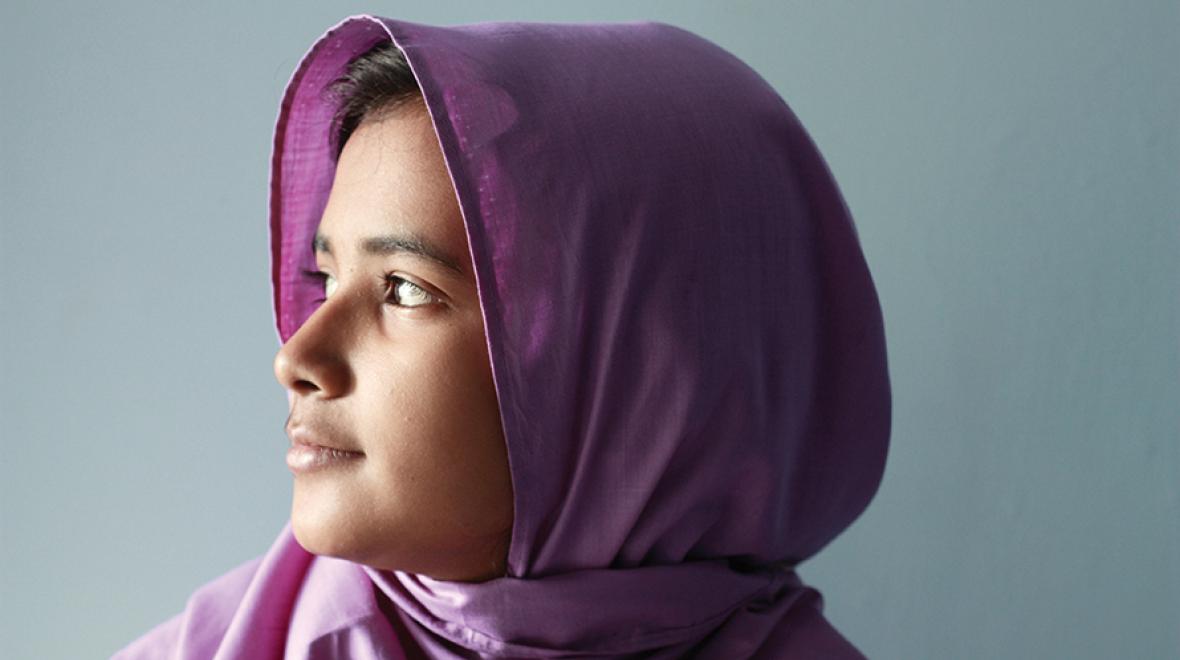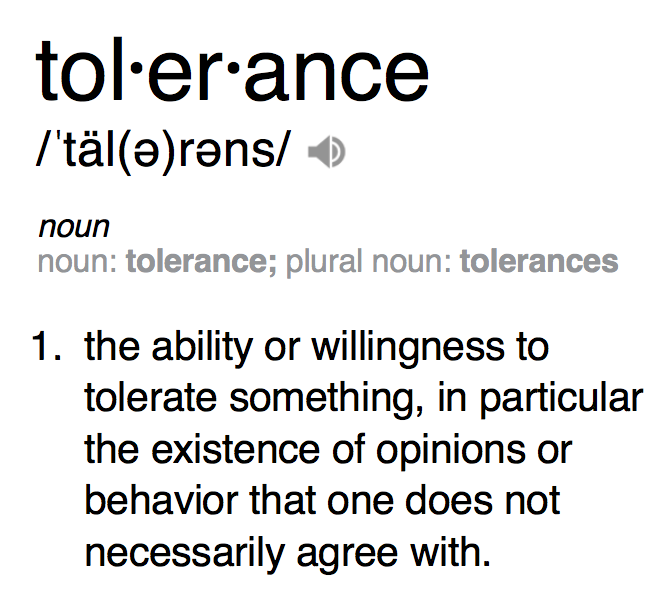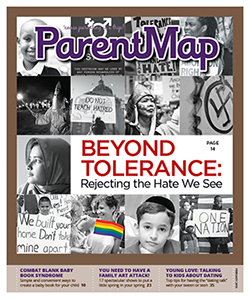
When some West Seattle residents woke to discover anti-Semitic graffiti spray-painted across the side of their garage last November, many neighbors were shaken and sad. But they weren’t particularly shocked. According to a recent FBI report, Washington’s rate of hate crimes is nearly twice the national average, increasing 32 percent from 2016 to 2017. Over the same time period, Seattle’s reported hate crimes doubled, from 118 to 234.
Nationwide, the Evergreen State ranks third for the number of per-capita hate crimes — from threats and acts of violence to rapes and homicides — behind Washington, D.C., and Kentucky. And it means that scrawled ethnic slurs and other displays of hate are increasingly common in a corner of the country that many associate with pristine natural scenery, an undaunted spirit that prioritizes perpetual innovation and progressive human potential, and a casual, live-and-let-live culture of tolerance.
|
For local parents, educators and youth advocates, scrambling to soothe fear, affirm safety and advocate for change in the wake of each hate-driven incident is daunting. So is working to shift a local culture that’s hardly isolated — what’s boiling over in Seattle is simmering nearly everywhere else across the United States, thanks to longstanding tensions around race, gender and religion.
Anti-Semitic vandalism is a troubling symbol of a broader intolerance that extends beyond religion, says Ilana Cone Kennedy, director of education for Seattle’s Holocaust Center for Humanity.
“Anti-Semitism doesn’t exist in a bubble — it’s a red flag for a climate of intolerance and racism,” she notes. “I’ve worked [at the center] since 2003, and I don’t remember ever getting the number of calls about these types of acts that we’re getting now.”

Apathy and injustice in Seattle
Rising intolerance in the laid-back, progressive Northwest isn’t as puzzling as it might seem when viewed through the lens of the region’s history of racial injustice, says Tacoma-based youth coach and advocate Lisa J. Keating, founder and CEO of antibullying and LGBTQ advocacy organization My Purple Umbrella.
“In the Pacific Northwest, we may be tolerant, but we’re not accepting. We want to appear inclusive, but we haven’t really healed from our history of oppressing indigenous people. We haven’t done restorative justice. It’s all intertwined. And the assumption is, if it doesn’t affect me, it’s not a problem,” says Keating.
The resulting apathy feeds bystander culture: the perception that we can skirt personal responsibility for wrongs committed by and against others so long as we don’t actively take part in perpetrating them. This creates a breeding ground for hateful acts in seemingly peaceful neighborhoods populated by people who are quick to denounce hate but slow to examine their own prejudices. “We’re passive-aggressive about our cultural biases, and still not really working to address them,” says Keating.
The Pacific Northwest is still one of the whitest regions in the United States, with local neo-Nazi groups working to attract white supremacists to Washington, Oregon and Idaho. “The Northwest has always been a home for white supremacist groups, which feeds into our culture,” says Kennedy. “But Seattle likes to see itself as extremely liberal, so we’ve fooled ourselves into thinking we don’t have these kinds of issues, and we’re caught off guard when we do.”
Talking about tolerance
Addressing problems created by systemic racial oppression, emboldened hate groups and apathetic bystanders starts with rethinking the term “tolerance.” The term implies passivity instead of inclusion, acceptance or understanding, says Keating. “I think ‘tolerance’ is too narrow in its scope. We’re evolved beyond that language. Beyond tolerance is acceptance and inclusion.”
“While ‘tolerance’ is passive, terms like ‘ally’ and ‘upstander’ are about standing up to the aggressor and standing with victims,” says Kennedy.
Building cultures that affirm and include marginalized groups means fostering understanding of the barriers faced by others, says Jeremiah J. Allen, strategic adviser for Transform Washington at Seattle’s Pride Foundation.
Celebrating differences is important, but the real work begins as celebrations end and brightly colored decorations are put away. “It’s great to celebrate, but understanding is what makes people feel accepted,” says Allen. “We need to build understanding at the intersections of race and gender and how these intersecting identities add up to and affect someone’s ability to access services or support.”
Rays of hope
An area in which Seattle’s progressive reputation may ring true is in its policy making. “While we’re not necessarily different from any other area in terms of safety or inclusion of marginalized groups, we do have nondiscrimination protections for LGBTQ people and students,” says Keating.
More such laws are on the horizon. Last year, Keating testified on behalf of legislation preventing harassment, intimidation and bullying of transgender students. Sponsored by Sen. Marko Liias, SB 5766 passed in the Senate in 2018.
Importantly, the bill states a requirement for “training of school district employees on policies and procedures related to nondiscrimination; transgender students; and antiharassment, intimidation and bullying.” Building capacity within each school is critical, because educators have their own biases to address and unlearn, says Keating.
The Northwest has always been a home for white supremacist groups, which feeds into our culture . . . But Seattle likes to see itself as extremely liberal, so we’ve fooled oursleves into thinking we don’t have these kinds of issues . . .
Another recent win: Washington’s new law restricting the practice of conversion therapy on patients under age 18. [The bill report defines conversion therapy as any therapeutic regimen “that seeks to change an individual’s sexual orientation or gender identity, including efforts to change behaviors or gender expressions, or to eliminate or reduce sexual or romantic attractions or feelings toward individuals of the same sex.”] “It’s something that took years, but it sends a message of hope to a lot of people,” says Keating.
Seattle citizens are affecting federal change, too. Prompted by recent threats against religious sites, including synagogues, Mercer Island resident Joseph Schocken and U.S. Rep. Derek Kilmer introduced bill S.994, establishing a criminal penalty for hate crimes that damage spaces or structures owned or leased by religious organizations. The bill passed in the U.S. House of Representatives and in the U.S. Senate in 2018.
There’s more hope on the horizon, too. “The Holocaust Center for Humanity is working with state legislators across party lines to ensure that the lessons of the Holocaust are standardized across all districts in Washington state,” says Holocaust Center for Humanity Executive Director Dee Simon. “As we speak, we’re working with legislators to develop a bill to bring Holocaust education to our schools.”
While laws aren’t an immediate fix for intolerance, they’re an important step, says Keating. “A law sets the bar of what is acceptable and what is not acceptable. It creates a standard to uphold.”
Building understanding in the classroom
Many local teachers can’t wait for new laws to be enacted and implemented, because they confront issues related to intolerance and hate every day — and more and more often these days — in their classrooms. One of the central missions of the Holocaust Center for Humanity is to provide antibias education and resources for teachers to use in their everyday work, says Kennedy. “One of the things that has really struck me is how many new teachers really want these resources in their classrooms. They see issues with intolerance, anti-Semitism and bias coming from their students. They’re looking for lessons about the Holocaust that they can use in an effective way.”
Teachers looking for this type of training can find it through the center’s in-person workshops for educators. In live sessions, as many as 30 teachers at a time learn about topics such as the American resistance to the Holocaust, “Holocaust 101” and how to address these pervasive issues in their classrooms.
. . . acceptance of neo-Nazi beliefs is nearly seven times higher among people without awareness of the Holocaust than among those with even a passing knowledge of Holocaust history.
During one weeklong summer workshop, which is now entering its fourth year, visiting scholars give presentations on topics such as the U.S. incarceration of Japanese-Americans during WWII and provide in-depth training on complex issues facing today’s teachers. Through these types of in-person trainings and resources (such as the popular Teaching Trunks free lending library of curated, age-specific Holocaust education materials), the center reaches 6,000 teachers each year, Kennedy says.
Teachers are interested in this type of training because it works, echoes Simon. “A number of studies show the importance of Holocaust education and its ability to increase empathy and self-awareness, as well as reduce bias and promote global citizenship,” she says. One study shows that acceptance of neo-Nazi beliefs is nearly seven times higher among people without awareness of the Holocaust than among those with even a passing knowledge of Holocaust history.
Dinner-table dialogue
At home, approaching weighty, complex issues with kids is sometimes simpler than we think, Kennedy notes. “Often, parents come with more baggage and information than kids want or need, when what kids are really looking for are answers to their questions, such as ‘What’s happening?’ and ‘Do I need to be afraid?’ When we listen to their questions, we can guide our children without letting our own fears rub off on them.”
Where can parents start? Children’s books like “A Princess of Great Daring!” by Seattle author and activist Tobi Hill-Meyer, other titles published by Flamingo Rampant and titles by multicultural author Maya Gonzalez are disarming, accessible tools for introducing these topics to kids, says Keating. “With my own daughter Stella, these books let us look at these themes in age-appropriate ways. I just find children’s books to be amazing social justice tools.”
Independent bookstores such as Seattle’s Elliott Bay Book Company and Tacoma’s King’s Books give kids and families access to nearly endless conversational tools to help build understanding, inspire inclusion and encourage acceptance. King’s Books is home to My Purple Umbrella’s Queerest Book Club Ever, the region’s only book club for queer youth.
And what if parents have graver or more immediate cause for concern? Families with questions about their student’s civil rights can contact the Office of Superintendent of Public Instruction’s (OSPI) Office of Equity and Civil Rights. “The OSPI has clearly stated guidelines and best practices, which lay out protections for students,” says Keating. “As a parent, if you have to go and have that scary conversation with your school principal and you find that you’re also having to do the educating, that’s overwhelming.”
Building cultures of understanding and acceptance doesn’t mean starting from scratch or working alone, says Allen. “We recommend collaborating with a community already doing this type of work. It’s okay to be afraid, and also okay to not know. We’re really interested in providing tools and opportunities for folks to learn.”
What’s encouraging is that grassroots efforts of just one teacher, one student or one family can make a meaningful difference, says Kennedy. “We’re finding that this type of education is working. We’re hearing from teachers and students that the climate in their classroom is changing, that the student culture is changing, that there’s a positive impact. For us, that’s the best evidence that [what we’re doing is] making a difference.”












